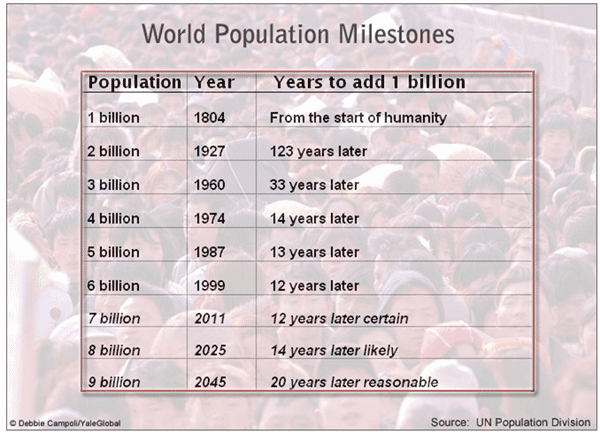The dangers of population explosion hit newspaper headlines as the US intelligence chief warns about it. Indeed the world population could reach 7 billion in just two years and 8 billion perhaps in next two decades. But that’s not the only story. Dramatic declines in fertility rates in some countries and high rates in others pose a critical challenge. Without restoring some balance, the world could be headed towards instability and turmoil.
One must be reminded that the growth of world population - which now stands at an estimated 6.8 billion human inhabitants - has greatly impacted all life forms and the entire natural environment on the planet.
Although the population of the world continues to grow substantially, 79 million a year, the rate of growth has declined by nearly half in the last 40 years - from 2.0 to 1.2 per cent per annum. The cause for the slowdown is declining fertility rates.
Advertisement
However, while average global fertility has dropped from about 5 to 2.6 births per woman during the past 50 years, considerable uncertainty exists about the future. Insofar as fertility is the engine driving the future size of world population, this uncertainty about the path of fertility in the coming years is one of the central and challenging questions of this century.
Prior to the 20th century, world population grew slowly because while fertility rates were high so were mortality rates. For example, between years 0 and 1500, world population is estimated to have grown from around 300 million to 500 million. The 1 billion population mark was reached at the start of the 19th century (see Table 1).

Table 1. World Population Milestones. Enlarge image
In striking contrast to the past, the 20th century ushered in the world’s most rapid rates of population growth because while mortality rates fell to relatively low levels, fertility rates generally remained comparatively high. World population nearly quadrupled during the past century, with 80 per cent of the growth occurring during its second half. The 2 billion mark was reached in 1927, 3 billion in 1960, 4 billion in 1974, 5 billion in 1987, 6 billion in 1999.
Behind these global population figures are enormous differences among regions and countries. For example, of the 79 million people added to the world every year, six of the most populous countries - India, China, Nigeria, Pakistan, Indonesia and Bangladesh - account for approximately half of this growth. India alone accounts for 21 per cent of global population growth, followed by China, which contributes 11 per cent. As a consequence, India’s population is expected to exceed China’s in about 20 years.
In contrast, among the more developed regions, little demographic growth is taking place. Many European countries and Japan are entering a period of population decline, and these trends are likely to continue. In contrast, Australia, Canada, New Zealand and the US are projected to continue growing due to relatively higher fertility and international migration.
Advertisement
In terms of annual rates of growth, the world’s most rapidly growing region is Africa due to the large gap between high birth rates and comparatively low death rates. During the last half century, Africa’s population more than tripled, increasing from 227 million to 819 million. High fertility and vigorous demographic growth are expected to continue, with the African continent projected to be 2 billion inhabitants by mid-century. The populations of Asia and Latin America are also expected to increase by about 25 per cent over the next 50 years.
While the future population growth remains uncertain, some trends are clear. First, most current rates of population growth are unsustainable over the long term. For example, if fertility rates were to remain fixed at today’s levels, then world population would exceed 11 billion by mid-century. Furthermore, while some countries, such as Germany, Italy, Japan and Russia, would decline to a small fraction of their current population size, others such as Ethiopia, Nigeria, Pakistan, Saudi Arabia and Yemen would increase many times their current size.
In the near term, there’s little doubt that the world’s population will reach 7 billion, probably by 2011. Will the world reach 8 billion? Most demographic observers would say that it’s highly likely, perhaps by 2025. After that, things become considerably less certain.
Reprinted with permission from YaleGlobal Online - www.yaleglobal.yale.edu - (c) 2008 Yale Center for the Study of Globalization.